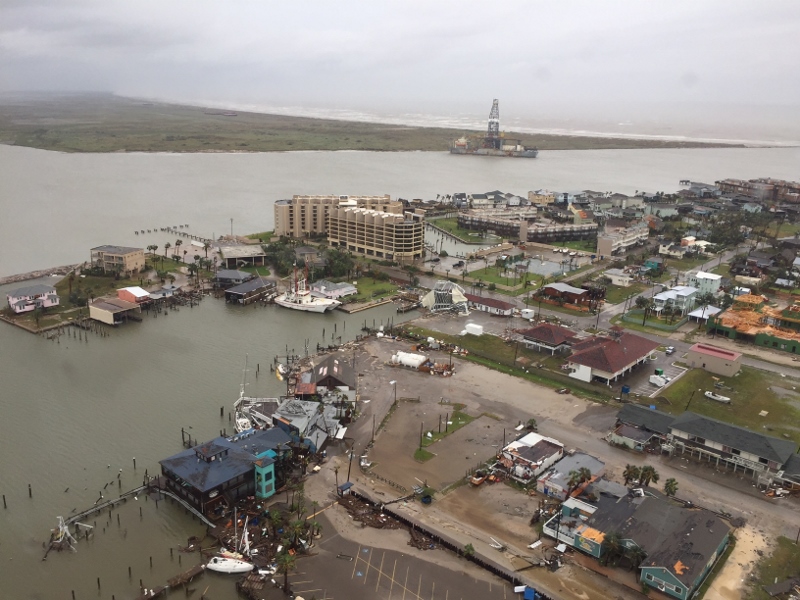With up to 50” of rain possible before Tropical Storm Harvey dissipates, the Texas coast and energy industry hub Houston appear bound for long-term disruption.
Coast Guard crews made 15 rescues Saturday morning, including three workboat crews in distress. At Port Aransas, seven people were rescued aboard the vessel Sabine and airlifted to a rig near Aransas Pass, and four from Higman Barge Lines' 71'x37' towboat Sandy Point. A helicopter aircrew and rescue swimmer brought ashore crewmembers from Signet Maritime’s 105’x34’, 4,400-hp tug Signet Enterprise, sunk in the harbor.
The operation involved two MH-65 helicopter crews in close collaboration and working with the crew of another tug, Signet’s 100’x40’x18’, 6,834-hp Signet Constellation.

A Coast Guard aircrew rescues crew members from the tug Signet Enterprise at Port Aransas, Texas, during Hurricane Harvey. Coast Guard photo
“To complete the evolution quickly and take these mariners out of harm’s way, the aircrews delivered the survivors to a drop off point and the Signet Constellation transported the survivors to a safer location,” Capt. Tony Hahn, commander of Coast Guard Sector Corpus Christi, said in statement. “This was a great effort between our Coast Guard aircrews and Signet Constellation’s crew in very dangerous conditions.”
Offshore energy companies evacuated 105 of the 737 manned production platforms in the Gulf of Mexico, and five of the 10 non-dynamically positioned rigs in operation, the federal Bureau of Safety and Environmental Enforcement reported Sunday. Only one of the 21 DP rigs operating in the Gulf had to move from the storm’s path, according to the BSEE.
The evacuations shut-in an estimated 21.64% of Gulf oil production, and about 25.71% of natural gas production. The effects on the energy business await damage assessments offshore and at Houston refineries, but markets on Sunday had little reaction, with West Texas intermediate crude still trading around levels a week previous at $47.94 bbl.
As Harvey’s winds dropped to tropical storm force and the storm moved over land, intense overnight rains reported at 24” in Houston and suburbs flooded thousands of homes. At first light Sunday the Coast Guard and state and local agencies were pivoted to search and rescue in residential neighborhoods.
Eight MH-65 helicopters from Air Station Corpus Christi and others as far away as Cape Cod, Mass., were at work Sunday morning and had airlifted more than 100 persons from homes before noon, with 500 more calling asking to be picked up, said Capt. Kevin Oditt, commander of Coast Guard Sector Houston-Galveston, in a telephone press briefing.

The drillship Paragon DPDS I at Port Aransas, Texas, after Hurricane Harvey. Coast Guard photo.
Eleven more MH-65s were bound for a rescue operations base set up at Ellington Field Joint Reserve Base, a Texas Air National Guard facility near Houston, where three Coast Guard boat teams were based with another moving there from Covington, La., said Oditt.
Boat owners in Houston, Galveston and other flooded communities pitched in to help evacuate neighborhoods, in scenes reminiscent of the post-Hurricane Katrina 2005 arrival of “Cajun Navy” volunteers with small boats in New Orleans.
The Louisiana Department of Wildlife and Fisheries dispatched a search and rescue team with 10 boats to Texas Sunday, with three more teams on standby. Social media is playing a big role in organizing relief – Texas county officials used Facebook and Twitter to recruit civilians with boats and high-clearance four-wheel drive vehicles.

More volunteers with boats were on their way from Louisiana too, networked on social media with the hashtag #CajunNavy.





